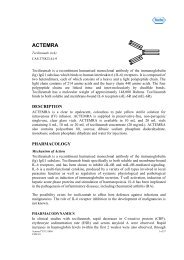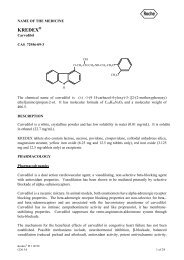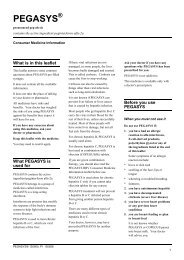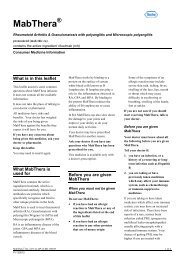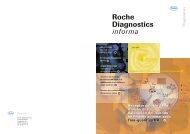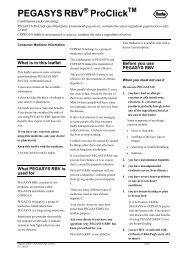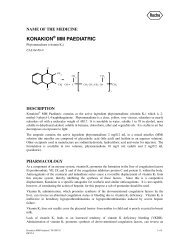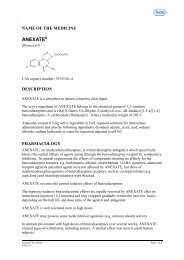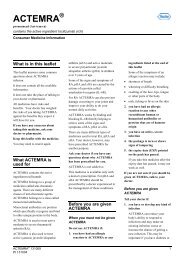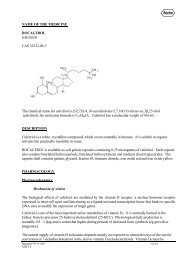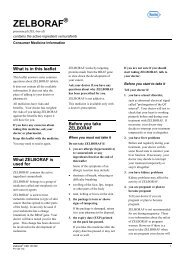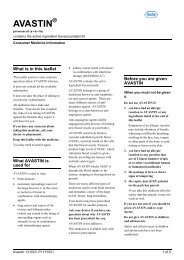Product Information PI - Roche Australia
Product Information PI - Roche Australia
Product Information PI - Roche Australia
Create successful ePaper yourself
Turn your PDF publications into a flip-book with our unique Google optimized e-Paper software.
toxicities were observed, respectively, in the 150 and 500 mg/kg/day groups. The duration of<br />
parturition was increased in rats at oral doses of 1500 mg/kg/day of oseltamivir phosphate,<br />
180 times human exposure (AUC 0-24h ), but it was not affected at 500 mg/kg/day<br />
(approximately 40 times human exposure). Oseltamivir phosphate was not teratogenic in<br />
these studies.<br />
Because animal reproductive studies may not be predictive of human response, and there are<br />
no adequate and well-controlled studies in pregnant women, TAMIFLU should be used<br />
during pregnancy only if the potential benefit justifies the potential risk to the foetus.<br />
While no controlled clinical trials have been conducted on the use of TAMIFLU in pregnant<br />
women, limited data available from post-marketing and retrospective observational<br />
surveillance do not indicate direct or indirect harmful effects with respect to pregnancy or<br />
embryonal/foetal development.<br />
Use in Lactation<br />
In lactating rats, oseltamivir and the active metabolite are excreted in milk. Very limited<br />
information is available on children breast-fed by mothers taking TAMIFLU and on excretion<br />
of oseltamivir in breast milk. Limited data demonstrated that oseltamivir and the active<br />
metabolite were detected in breast milk at very low levels. TAMIFLU should be used in<br />
lactating mothers only if the potential benefit for the lactating mother justifies the potential<br />
risk of exposure of the medicine to the nursing infant.<br />
Paediatric Use<br />
The safety and efficacy of TAMIFLU in paediatric patients have not been established in<br />
children aged less than 1 year of age. TAMIFLU should not be used in children under 1 year<br />
of age (see Toxicology).<br />
No studies have been carried out in paediatric patients with hepatic impairment.<br />
There is insufficient clinical data available in children with renal impairment to be able to<br />
make any dosing recommendation.<br />
Use in Elderly Patients<br />
Limited numbers of subjects aged ≥ 65 years old have been included in the clinical trials.<br />
However, on the basis of drug exposure and tolerability, dose adjustments are not required for<br />
elderly patients unless there is co-existent renal impairment (see PHARMACOLOGY and<br />
DOSAGE AND ADMINISTRATION).<br />
Toxicology<br />
In unweaned rats a single oral dose of oseltamivir phosphate 500 mg/kg (free base equivalent)<br />
to 7-day old pups resulted in deaths associated with high exposure to the prodrug. However,<br />
at 1520 mg/kg in 14-day old unweaned pups, there were no deaths or other significant effects.<br />
No adverse effects occurred at 300 mg/kg administered to 7-day old rats. This dose level<br />
resulted in maximum plasma concentrations of 42.4 μg/mL for the prodrug and 9.4 μg/mL for<br />
Tamiflu <strong>PI</strong> 6 mg/mL oral suspension and capsules 120119 13 of 28<br />
CDS 10.0



